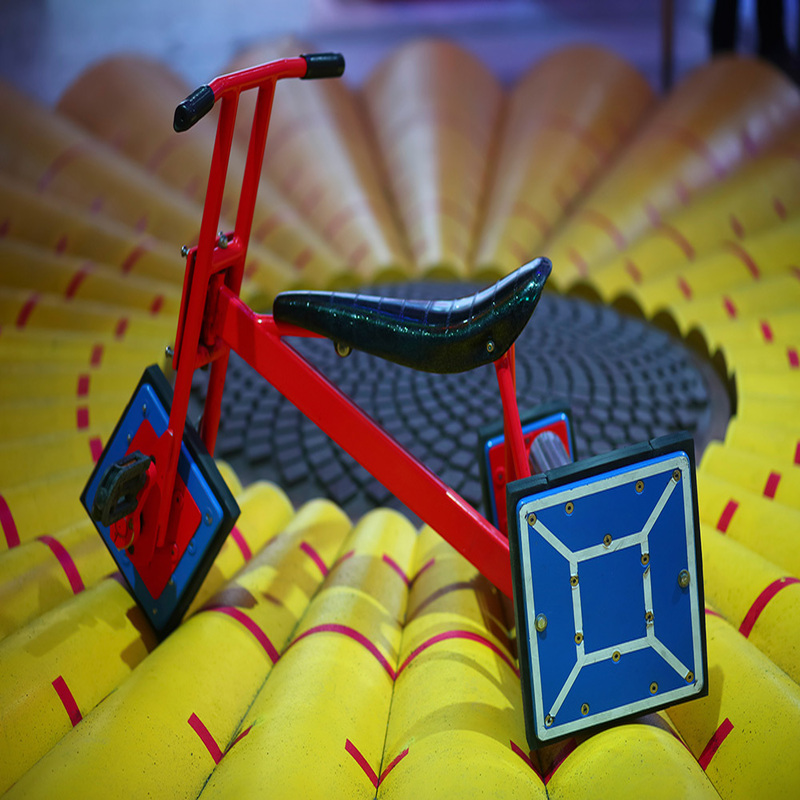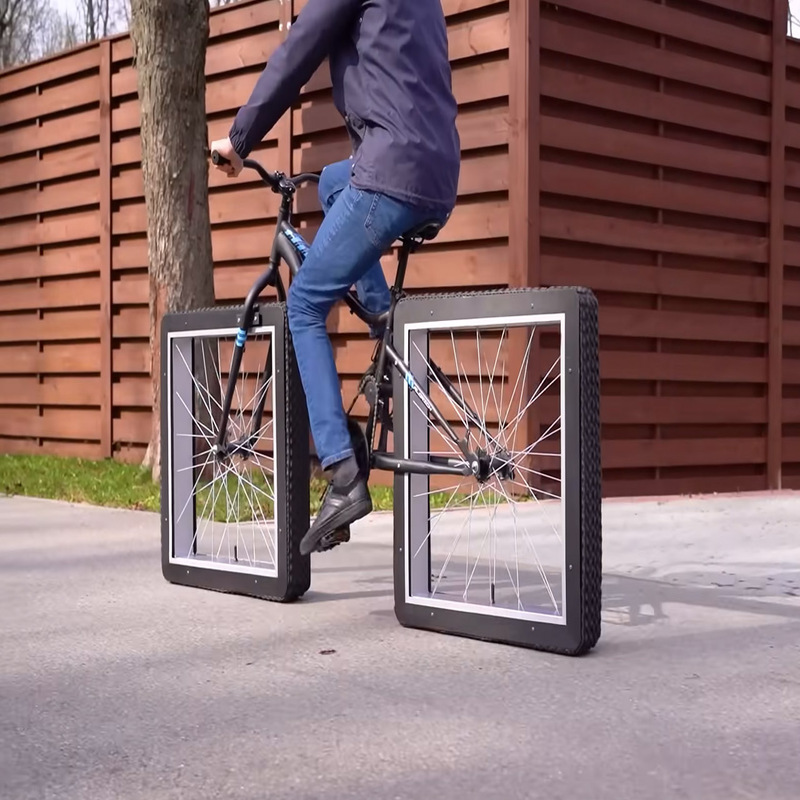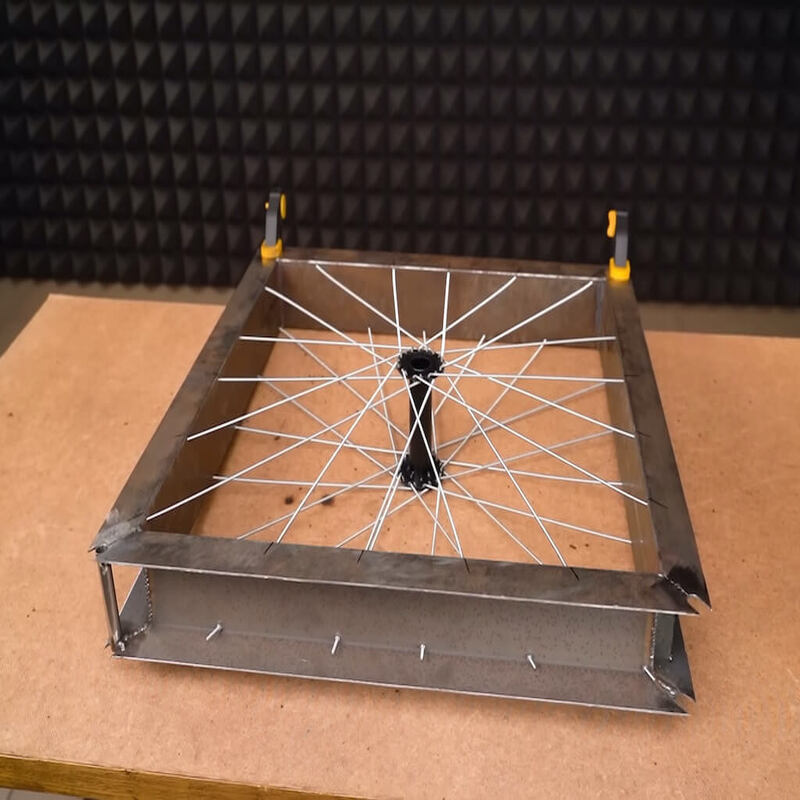The concept of a square wheel bicycle is both intriguing and perplexing. This unusual invention challenges our understanding of mechanics and bicycle design. Most of us consider round wheels as an essential component of bicycles. Therefore, a square wheel seems almost counterintuitive. However, exploring this idea can offer insights into physics, creativity, and innovation.
Understanding the Mechanics of Square Wheels
The mechanics behind square wheels are fun and complex. It is crucial to understand how shapes affect motion in any machine. Wheels typically roll smoothly on surfaces, providing efficient movement. In contrast, a square wheel presents unique challenges, but it is not entirely impractical.
The Geometry of Motion
When analyzing the square wheel, geometry plays a vital role. A square wheel does not roll in the conventional sense. Instead, it pivots around its corners, creating a series of bumps. This zig-zag movement can generate a rhythm. Surprisingly, this rhythmic motion can be somewhat functional in specific contexts. A square wheel can achieve a rolling effect on a specially designed surface.
The design of this surface is fundamental. Engineers can construct a wavy path that complements the square wheel’s unique shape. This mutually beneficial relationship allows the square wheel to move with relative ease. The dips and rises of the surface engage the corners of the square. Consequently, this design forms a creative solution to a challenging problem.
Challenges and Solutions
While the mechanics of square wheel bicycles are fascinating, challenges remain. For instance, pedaling becomes more strenuous due to the uneven terrain. They require additional energy when moving at a speed common for traditional bicycles. Nevertheless, innovative solutions do exist to address this issue.
One potential solution involves modifying the bike’s gearing. By altering the gear ratio, riders can compensate for the effort needed to pedal. Additionally, riders can learn to anticipate the bumps caused by each corner. This anticipation helps improve overall efficiency. Thus, while the challenges of a square wheel bike are evident, they also create opportunities for innovation.

Applications of Square Wheel Bicycles
Square wheel bicycles may initially seem impractical. However, they can serve educational and entertainment purposes. Schools and museums often use them to teach principles of engineering and physics. The unusual design encourages curiosity among students.
Educational Insights
Educational settings benefit tremendously from square wheel bicycles. They visualize concepts like kinetic energy and friction in a captivating way. Students can grasp these principles while engaging in hands-on experiences. Furthermore, this interactive learning motivates students to explore complex topics.
Also, workshops often discuss the effect of shape on movement. In these sessions, inspiration can lead to innovative designs in other contexts. By making learning fun, square wheel bicycles help instill a sense of wonder. They encourage future engineers to think outside the box. This out-of-the-box thinking is essential in this increasingly complex world.
Recreational Use
In recreational situations, square wheel bicycles can be entertaining. Parks and community events occasionally feature obstacle courses that include these bikes. Such activities offer a unique twist on traditional cycling. Riders experience the thrill of conquering an unusual challenge. Furthermore, it promotes social interaction among participants.
This provides an opportunity for laughter and shared memories. Unexpected challenges can be engaging and thought-provoking. Additionally, they often spark conversations about engineering, design, and innovation. Life can often feel predictable, but square wheel bicycles break that mold.
The Engineering Perspective
From an engineering standpoint, square wheel bicycles offer exciting possibilities. Engineers study various shapes and their effects on motion. Surprisingly, even unconventional designs have their own advantages.
Design Experimentation
Design experimentation is a critical part of the engineering process. Testing different wheel shapes can provide valuable insights. For example, engineers can experiment with various geometries to gauge efficiency. This experimentation can also inspire new ideas for future projects.
Moreover, materials play a significant role in a square wheel bicycle’s design. These engineers can utilize lightweight, durable materials to create effective bikes. Such innovations can ultimately lead to breakthroughs in more conventional bicycle designs.
Case Studies in Innovation
Case studies involving square wheels demonstrate their potential. Various inventors have attempted to solve problems creatively. The intersection of art and science can unlock new possibilities. By documenting these experiments, future engineers may find inspiration.
These documented experiences often evolve into full-fledged designs. Lessons learned from square wheels can resonate throughout the engineering community. This sharing of knowledge emphasizes the importance of collaboration and exploration. Thus, the square wheel bicycle acts as a catalyst for creativity.

The Role of Art and Creativity
The square wheel bicycle represents the intersection of engineering and art. This unique design transcends conventional boundaries, sparking interest and creativity. It challenges preconceived notions about functionality and aesthetics.
Artistic Inspiration
Artists can find inspiration in the unconventional design of square wheel bicycles. Their visual appeal lies in the juxtaposition of squares against circular norms. This contrast prompts deeper exploration into how art can influence design.
Moreover, this concept invites artists to engage in different forms of expression. Sculptures, murals, and interactive installations could stem from such an idea. The artistic community benefits from exploring unconventional themes, expanding the conversation around design.
Creative Collaborations
Interdisciplinary collaboration fosters creativity and innovation. When engineers and artists join forces, extraordinary projects can emerge. Square wheel bicycles are just one example of how collaboration can take shape.
These partnerships encourage dynamic problem-solving and out-of-the-box thinking. They bring two diverse perspectives together, leading to fresh ideas. By recognizing each other’s expertise, teams can tackle challenges collaboratively. Ultimately, this leads to creative solutions that may not have been possible independently.
Real-World Implications
The implications of square wheel bicycles extend beyond recreational and educational use. They have the potential to inspire broader discussions about design and engineering. Recognizing the value of unconventional ideas is crucial in today’s fast-paced world.
Challenging Norms
An awareness of alternative designs encourages challenges to established norms. Embracing the unconventional can lead to innovative breakthroughs. As technology continues to evolve, it is essential to question traditional designs.
Many groundbreaking inventions began as unconventional ideas. By remaining open to new concepts, we can explore untapped potential. This approach should permeate all industries and fields, inspiring future innovations.
Encouraging Future Innovators
Inspiring emerging innovators is vital for the evolution of design. Square wheel bicycles serve as a symbol of creative thinking. They encourage future generations to approach challenges differently. By fostering curiosity and enthusiasm, we cultivate an environment ripe for innovation.
Moreover, engaging young minds fosters a passion for science and engineering. This passion can significantly influence careers in technology and design. Therefore, square wheel bicycles can ignite conversations and inspire dreams.

Conclusion: The Square Wheel Bicycle as a Learning Tool
The square wheel bicycle serves as an excellent educational tool. Its unconventional design promotes curiosity, engagement, and innovative thinking. By challenging established norms, it encourages people to explore new ideas.
Furthermore, it serves as a testament to the power of creativity and collaboration. Mixing engineering with art leads to unexpected discoveries. Such interactions are vital for innovation in all fields.
In summary, square wheel bicycles exemplify how creativity and engineering can work together. They inspire us to rethink our approach to challenges. Embracing the unconventional can yield remarkable results. So, let us continue to explore the fascinating world of square wheel bicycles. It is through these explorations that we can pave the way to a more innovative future.


